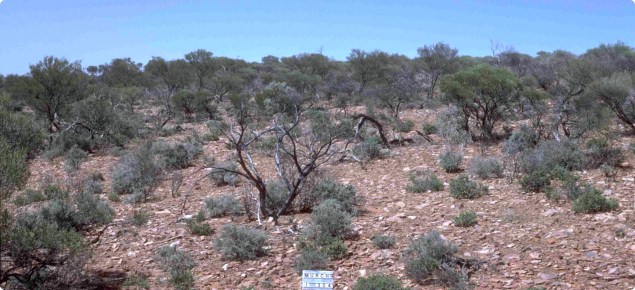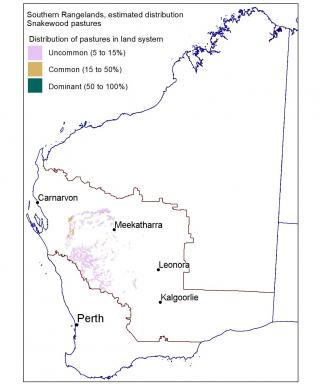Pastoral potential – moderate
Snakewood pastures are of moderate pastoral value. The low shrubs include desirable palatable species which are preferred by livestock and provide high quality feed in dry seasons. These may be augmented by isolated perennial grasses and a range of forbs and herbs in season. Snakewood (Acacia xiphophylla) is a poor feed and grazed only as a last resort. Snakewood pastures in good condition can support all classes of stock on a year-long basis provided stocking rates are low enough. These pastures have no durability in dry times when in poor condition, as forage is reduced to annual herbs and grasses in season.
Suggested levels of use (per annum)
Table 1 provides a rough guide to the range of pastoral values for good condition pastures, which must be checked against conditions in each region and paddock. Carrying capacities for fair condition pastures might be 75% to 50% of good, and poor condition pastures less than 50% of good.
See Introduction to pastures in the southern rangelands of Western Australia for an explanation of how carrying capacities are estimated.
| Condition | Carrying capacity ha/DSE1 | Carrying capacity ha/CU2 (ha/AE3) |
|---|---|---|
| Good | 15–19.9 | 105–139 (126–167) |
1 DSE is based on the feed energy required to maintain a 45 kilogram liveweight Merino wether with zero weight change, no wool growth additional to that included in maintenance, and walking 7 km/day. 1 DSE has an energy requirement of approximately 8.7 MJ ME/day.
2 CU in the southern rangelands is based on a 400 kg steer at maintenance and equivalent to 7 DSE.
3 AE is based on the feed energy to maintain a 450 kg Bos taurus steer 2.25 years of age, walking 7 kilometers each day. 1 AE has an energy requirement of approximately 73 MJ ME/day and equivalent to 8.4 DSE.
Management
These pastures are prone to degradation. Management should aim to maintain the productivity and vigour of the palatable low shrubs. Grazing can be continuous for a number of years but a strategy of occasional spelling for three to six months after good rains, on a paddock-by-paddock basis, is recommended to maintain these pastures. Pastures in poor condition may require spelling over consecutive growing seasons to allow recovery.
Pasture condition
Surveys and rangeland condition assessment data indicate that snakewood pastures in the southern rangelands are widely degraded and that the pastoral value is well below potential. Where the vegetation is severely degraded, soil erosion is common.
Good
See Figure 1. A number of palatable low shrubs will be concentrated around the bases of larger shrubs and trees (snakewood and wait-a-while) and persisting in the spaces between. Sparse tussocks of desirable grasses such as curly windmill grass also grow under snakewood. The inter-shrub spaces support very scattered stands of low shrubs, some of which are palatable.
Common desirable indicator species include ruby saltbush, warty-leaf eremophila, bluebushes and tall saltbush.
Fair
See Figure 2. There is an obvious loss of palatable species. Snakewood pastures in fair condition still support palatable shrubs under the snakewood and other large shrubs, but populations are reduced to perhaps two or three individuals under each tree. Sensitive indicators such as ruby saltbush and warty-leaf eremophila occur only as old, heavily used (grazed) individuals. The density of palatables in the inter-shrub spaces is reduced and there may be an increase in unpalatable shrubs such as cassias.
The presence of a stony mantle reduces susceptibility to erosion.
Poor
See Figure 3. The trend of declining cover and density of palatable shrubs continues with a change from fair to poor condition. Palatable shrubs and grasses are absent or occur only as occasional heavily-grazed remnants under the snakewood or in open spaces. Tall saltbush is among the last of the hardy palatables to disappear under excessive grazing pressure. Undesirable woody shrubs such as bardie bush may replace the snakewoods.
Snakewood pastures condition photographs
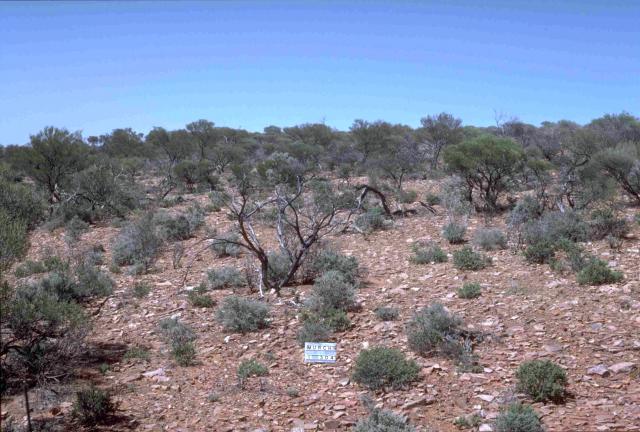
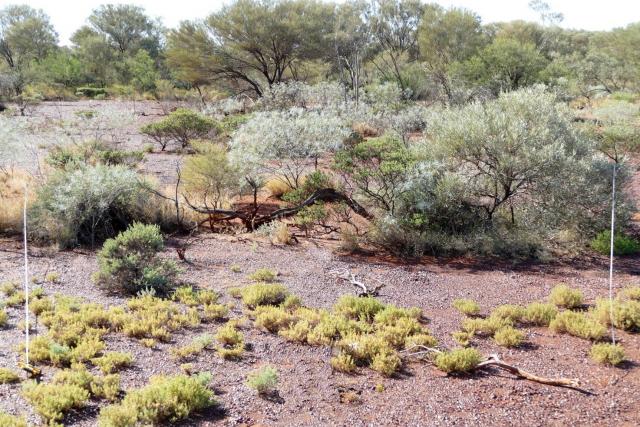
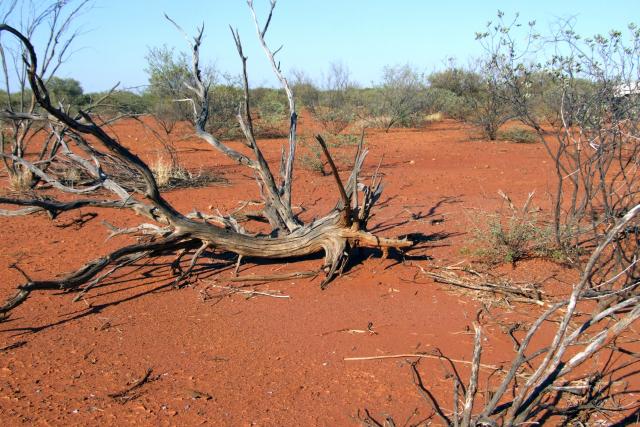
Vegetation structure and composition
Snakewood pastures are characteristically tall (>2 m) shrublands dominated by snakewood with a patchy understorey of chenopod shrubs (saltbush and bluebush), other low shrubs and a few perennial grasses. The low shrubs tend to be clumped beneath the protection of the taller snakewood and are sparser in the inter-snakewood spaces. Snakewood pastures also support areas of wait-a-while as a tall shrub that may be dominant. Low shrubs often dominate these pastures, comprising a mix of chenopods; mainly three-winged bluebush, sago bush, golden bluebush, pussy bluebush, ball leaf bluebush, felty leaf bluebush, ruby saltbush, silver saltbush, tall saltbush and bindii.
Unpalatable species such as silver poverty bush, needlebush and bardie bush are often present, but do not dominate.
The overall density of shrubs is usually scattered to moderately close with projected foliar cover of 10–25%.
Occurrence
Snakewood pastures are widespread and locally dominant in the north of the Murchison River region as stony snakewood shrublands, merging into stony chenopod pastures in the Carnarvon Basin, and snakewood chenopod pastures in the Pilbara. These pastures cover an estimated 0.22 million hectares (0.3% of the southern rangelands). Stony snakewood pastures intergrade with bluebush, mulga chenopod and saltbush shrubland. Snakewood chenopod pastures are described in the Pilbara pasture condition guide.
Snakewood pastures typically occur on interfluvial slopes and plains that receive run-on, usually on slightly saline, alkaline and sometimes calcareous soils. Shallow red duplex soils with pebbly or gravelly mantles are common. These pastures often occur on saline stony rises adjacent to salt lakes or river systems.
Associated plants
| Common name | Scientific name (links to FloraBase) | Desirability* |
|---|---|---|
| Ball leaf bluebush | D | |
| Buffel grass | Cenchrus ciliaris (alien) | D |
| Cotton bush | D | |
| Creeping cassia | D | |
| Curly windmill grass | D | |
| Felty leaf bluebush | D | |
| Gascoyne bluebush | D | |
| Golden bluebush, George's bluebush | D | |
| Horse mulla mulla | D | |
| Mulga bluebush | D | |
| Creeping sida | D | |
| Pussy bluebush | Maireana melanocoma | D |
| Roebourne plains grass | Eragrostis xerophila | D |
| Ruby saltbush | Enchylaena tomentosa | D |
| Shy bluebush | Maireana platycarpa | D |
| Silver saltbush | Atriplex bunburyana | D |
| Snakewood | Acacia xiphophylla | D |
| Tall saltbush | Rhagodia eremaea | D |
| Warty-leaf eremophila | Eremophila latrobei | D |
| Bardie bush | U | |
| Needlebush | U | |
| Silver cassia, banana-leaf cassia | Senna artemisioides subsp. x artemisioides | U |
| Silver poverty bush | Eremophila pterocarpa | U |
| Straight leaf cassia | Senna sp. Meekatharra | U |
| Straight leaf cassia, variable cassia | Senna artemisioides subsp. x sturtii | U |
| Wait-a-while | Acacia cuspidifolia | U |
| Bindiis | Sclerolaena spp. | I |
| Bloodbush | Senna artemisioides subsp. oligophylla | I |
| Curara | Acacia tetragonophylla | I |
| Currant bush | Scaevola spinescens | I |
| Flannel bush | Solanum lasiophyllum | I |
| Gascoyne mulla mulla | Ptilotus polakii | I |
| Mulga | Acacia aneura | I |
| Sago bush | Maireana pyramidata | I |
| Three-winged bluebush | Maireana triptera | I |
| White cassia | Senna glutinosa subsp. x luerssenii | I |
* D = desirable, U = undesirable, I = intermediate, N = no indicator value

